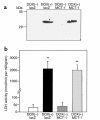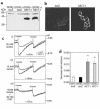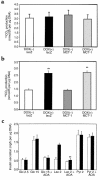Overexpression of monocarboxylate transporter and lactate dehydrogenase alters insulin secretory responses to pyruvate and lactate in beta cells
- PMID: 10587526
- PMCID: PMC409861
- DOI: 10.1172/JCI7515
Overexpression of monocarboxylate transporter and lactate dehydrogenase alters insulin secretory responses to pyruvate and lactate in beta cells
Abstract
Previous investigations revealed low activities of lactate dehydrogenase (LDH) and plasma membrane monocarboxylate transporters (MCT) in the pancreatic beta cell. In this study the significance of these characteristics was explored by overexpressing type A LDH (LDH-A) and/or type 1 MCT (MCT-1) in the clonal INS-1 beta cells and isolated rat islets. Inducible overexpression of LDH-A resulted in an 87-fold increase in LDH activity in INS-1 cells. Adenovirus-mediated overexpression of MCT-1 increased lactate transport activity 3.7-fold in INS-1 cells. Although overexpression of LDH-A, and/or MCT-1 did not affect glucose-stimulated insulin secretion, LDH-A overexpression resulted in stimulation of insulin secretion even at a low lactate concentration with a concomitant increase in its oxidation in INS-1 cells regardless of MCT-1 co-overexpression. Adenovirus-mediated overexpression of MCT-1 caused an increase in pyruvate oxidation and conferred pyruvate-stimulated insulin release to isolated rat islets. Although lactate did not stimulate insulin secretion from control or MCT-1-overexpressing islets, co-overexpression of LDH-A and MCT-1 evoked lactate-stimulated insulin secretion with a concomitant increase in lactate oxidation in rat islets. These results suggest that low expression of MCT and LDH is requisite to the specificity of glucose in insulin secretion, protecting the organism from undesired hypoglycemic actions of pyruvate and lactate during exercise and other catabolic states.
Figures






References
-
- DeFronzo RA. Lilly Lecture 1987. The triumvirate: β-cell, muscle, liver. A collusion responsible for NIDDM. Diabetes. 1988;37:667–687. - PubMed
-
- Prentki M. New insights into pancreatic β-cell metabolic signaling in insulin secretion. Eur J Endocrinol. 1996;134:272–286. - PubMed
-
- Matschinsky FM. Banting Lecture 1995. A lesson in metabolic regulation inspired by the glucokinase glucose sensor paradigm. Diabetes. 1996;45:223–241. - PubMed
-
- MacDonald MJ. Influence of glucose on pyruvate carboxylase expression in pancreatic islets. Arch Biochem Biophys. 1995;319:128–132. - PubMed
Publication types
MeSH terms
Substances
Grants and funding
LinkOut - more resources
Full Text Sources
Other Literature Sources
Medical
Miscellaneous

